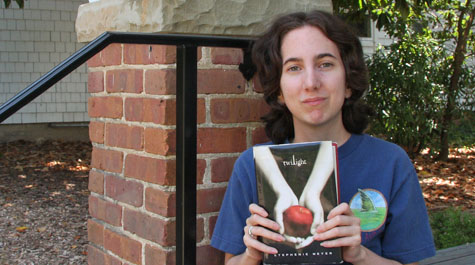W&M student examines representations of women in vampire pop culture
Rebeca Garcia, a senior, received a Charles Center research scholarship to study representations of women in teen vampire culture. Her project, titled "From Buffy to Twilight," focuses on the "Twilight" books as well as the late 1990s television show "Buffy the Vampire Slayer."
"I'm covering not just female identity but why a certain construction of female identity has proven to be so essential or so important in how a generation defines itself," said Garcia.
Garcia, who is a psychology major and women's studies minor, said that the project grew from a class in which they discussed backlash against the feminist movement and the work of author and journalist Susan Faludi.
"I got the idea to study how we've gone from Buffy - who is this very powerful, empowered young female vampire slayer - to Bella Swan, who is much more of a passive, gothic heroine," said Garcia.
Buffy Summers, the title character of "Buffy the Vampire Slayer," is an epic hero who follows many of the steps outlined by Joseph Campbell in his book, "The Hero with a Thousand Faces," said Garcia.
"You have the idea of this teenage every woman who is fighting evil and goes through these epic hero steps that you normally only see in males," she said.
That characterization likely blossomed from the "girl power movement" that occurred in the 1990s, Garcia noted.
"That was the time of the Spice Girls, and Buffy really focused a lot on just empowering women," she said. "She's a hero who is facing down a lot of these issues that challenge young women."
However, Bella Swan, the main female character in the "Twilight" books, is more of a gothic heroine who looks for her identity in her relationship with vampire Edward Cullen.
"Basically, Twilight is a modern day gothic," said Garcia. "You have the Byronic hero who's tortured and tormented and you have a virginal gothic heroine, who needs to be saved by the hero."
One of the books Garcia has been looking at in her research focuses on gothic heroes and heroines in the late 1800s.
"They put some interesting theories forward, like the idea that when the gothic heroine falls in love with the gothic hero, she is in a sense trying to find her own identity," said Garcia. "By falling in love with the gothic hero, she is in fact establishing her own identity as a young adult."
That search is evident in the story of Bella, said Garcia.
"You see Bella who at the beginning of Twilight has very little sense of self. She has no real personality, and allows the people around her to define her ," she said. "And when she falls in love with Edward, she not only has this sense of instant love and instant home, but she also has this new identity to the point that when he leaves, she is nothing without him."
And, as the influence of "girl power" movement can be seen in "Buffy," a different movement can be seen reflected in the "Twilight" books, Garcia said.
"I feel like there's more of an emphasis on preserving purity in ‘Twilight' that you don't really see in ‘Buffy,'" said Garcia. "I think that's tied to the purity movement that has been rising to the forefront over the last decade."
While Garcia has been examining both the show and books themselves, she has also been taking a look at American society's reactions to each. One of the sources that Garcia has looked at for that angle has been reviews found on amazon.com.
"It's interesting to see why people say they like Twilight," she said. "On Amazon, I kept seeing certain words repeated over and over again, like ‘fantasy' and ‘perfect love.' It was interesting that there a lot of older women on there, too, who said they were married with two kids and that reading Twilight gave them a look back into their younger days."
Like "Twilight" today, "Buffy" was also quite popular during its time, Garcia noted.
"'Buffy' got a strong reaction but it was more an empowering reaction, whereas I feel that Twilight just encourages young women to disappear into a world of fantasy, where a vampire like Edward can sweep them off their feet," she said.
A "Buffy" fan herself, Garcia has friends who love the "Twilight" series and others who loathe it. Though she probably would not have bought the "Twilight" books if she weren't doing this project, Garcia said she understands why many may find vampires so appealing.
"Vampires are a great way to deal with the problems of adolescence," she said. "I know a lot of people who made a big deal about the vampire boyfriend, and I feel like for a lot of teens in a way, the vampire boyfriend is like the ultimate fantasy," she said.
"(For instance) Edward is very caring and doesn't pressure Bella into anything she doesn't want to do when it comes to sexuality - so in a way, he's the perfect boyfriend in that fashion, but he also provides a sense of danger and excitement that you probably wouldn't get from a real-life relationship, or you shouldn't get from a real-life relationship. He simultaneously satisfies all these different urges young women have, which can be a really intriguing fantasy for the adolescent girl."
Garcia must deliver her completed project in by the end of the summer and present her findings at a research symposium in the fall. But in the meantime, people interested in her research can read about it on her blog.
 Skip to main content
Skip to main content

